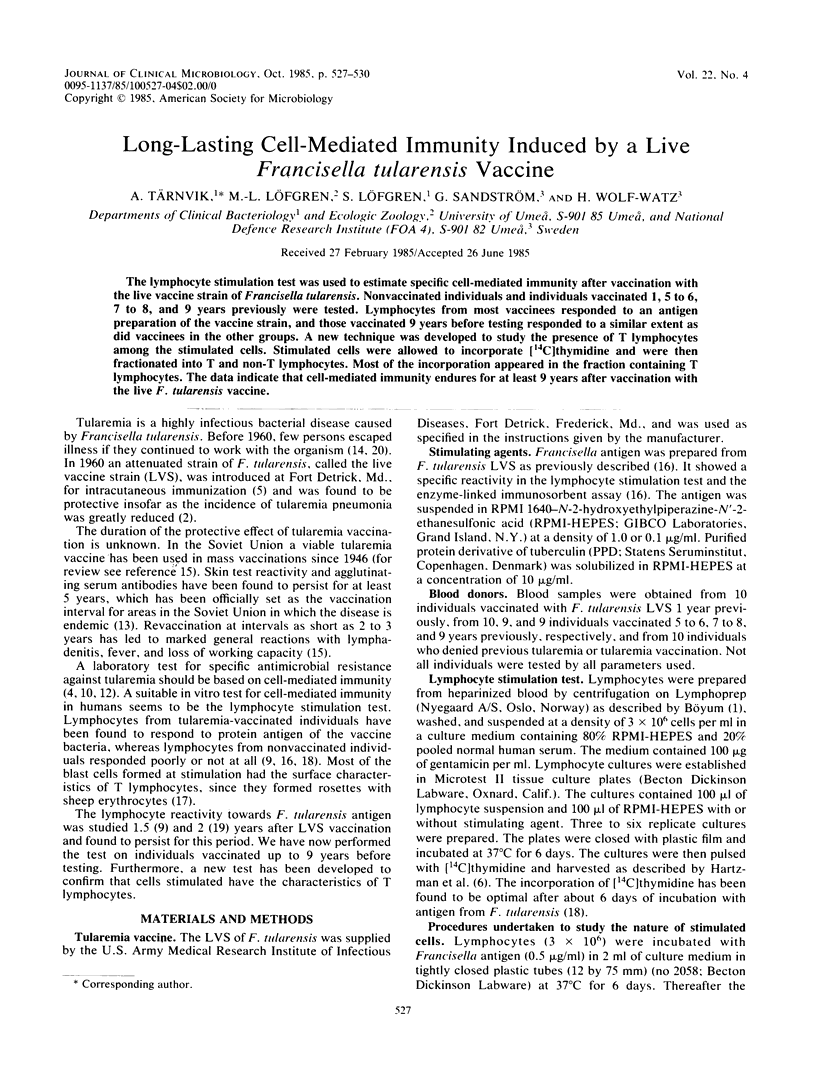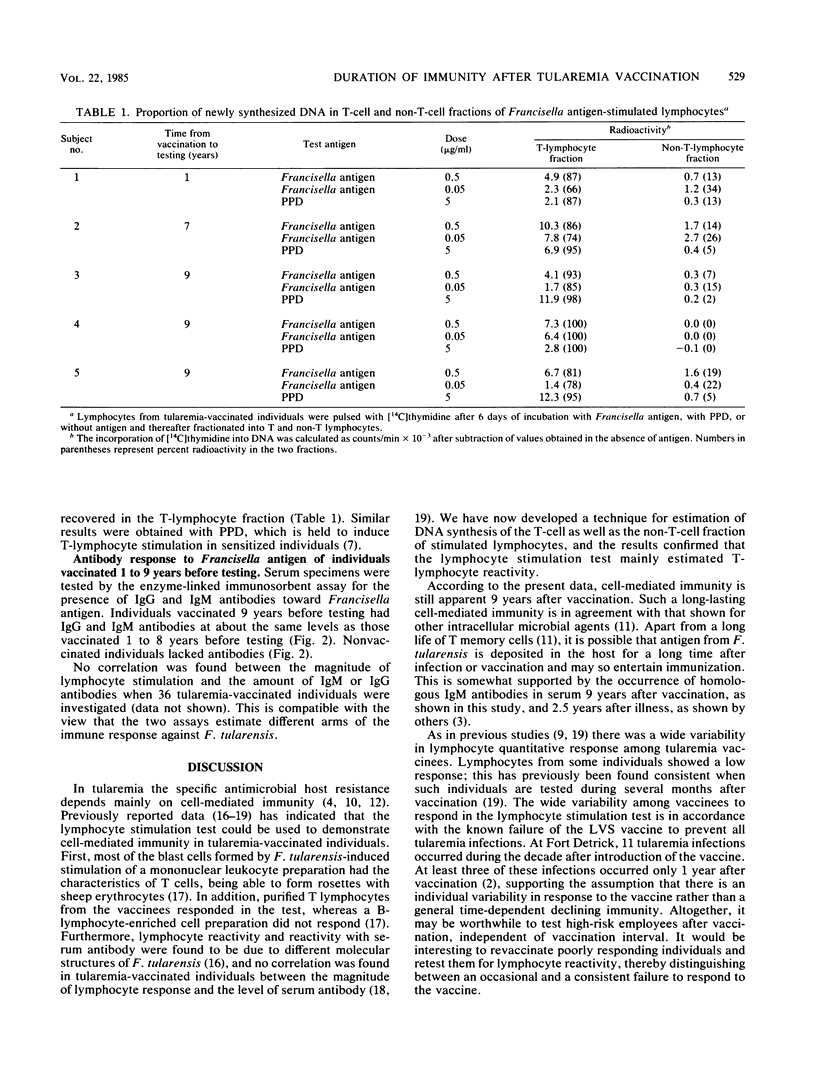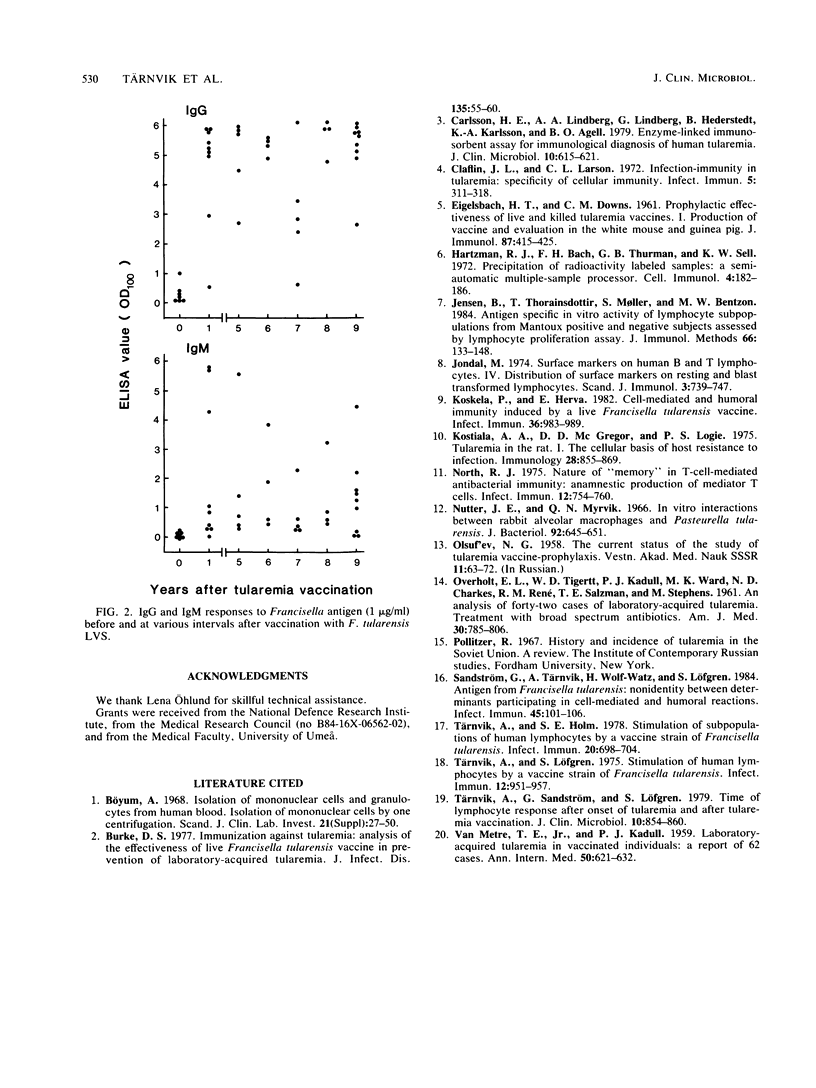Abstract
The lymphocyte stimulation test was used to estimate specific cell-mediated immunity after vaccination with the live vaccine strain of Francisella tularensis. Nonvaccinated individuals and individuals vaccinated 1, 5 to 6, 7 to 8, and 9 years previously were tested. Lymphocytes from most vaccinees responded to an antigen preparation of the vaccine strain, and those vaccinated 9 years before testing responded to a similar extent as did vaccines in the other groups. A new technique was developed to study the presence of T lymphocytes among the stimulated cells. Stimulated cells were allowed to incorporate [14C]thymidine and were then fractionated into T and non-T lymphocytes. Most of the incorporation appeared in the fraction containing T lymphocytes. The data indicate that cell-mediated immunity endures for at least 9 years after vaccination with the live F. tularensis vaccine.
Full text
PDF



Selected References
These references are in PubMed. This may not be the complete list of references from this article.
- Burke D. S. Immunization against tularemia: analysis of the effectiveness of live Francisella tularensis vaccine in prevention of laboratory-acquired tularemia. J Infect Dis. 1977 Jan;135(1):55–60. doi: 10.1093/infdis/135.1.55. [DOI] [PubMed] [Google Scholar]
- Carlsson H. E., Lindberg A. A., Lindberg G., Hederstedt B., Karlsson K. A., Agell B. O. Enzyme-linked immunosorbent assay for immunological diagnosis of human tularemia. J Clin Microbiol. 1979 Nov;10(5):615–621. doi: 10.1128/jcm.10.5.615-621.1979. [DOI] [PMC free article] [PubMed] [Google Scholar]
- Claflin J. L., Larson C. L. Infection-immunity in tularemia: specificity of cellular immunity. Infect Immun. 1972 Mar;5(3):311–318. doi: 10.1128/iai.5.3.311-318.1972. [DOI] [PMC free article] [PubMed] [Google Scholar]
- EIGELSBACH H. T., DOWNS C. M. Prophylactic effectiveness of live and killed tularemia vaccines. I. Production of vaccine and evaluation in the white mouse and guinea pig. J Immunol. 1961 Oct;87:415–425. [PubMed] [Google Scholar]
- Hartzman R. J., Bach M. L., Bach F. H., Thurman G. B., Sell K. W. Precipitation of radioactively labeled samples: a semi-automatic multiple-sample processor. Cell Immunol. 1972 Jun;4(2):182–186. doi: 10.1016/0008-8749(72)90018-4. [DOI] [PubMed] [Google Scholar]
- Jensen B., Thorarinsdottir T., Møller S., Bentzon M. W. Antigen specific in vitro activity of lymphocyte subpopulations from Mantoux positive and negative subjects assessed by lymphocyte proliferation assay. J Immunol Methods. 1984 Jan 20;66(1):133–148. doi: 10.1016/0022-1759(84)90256-4. [DOI] [PubMed] [Google Scholar]
- Jondal M. Surface markers on human B and T lymphocytes. IV. Distribution of surface markers on resting and blast-transformed lymphocytes. Scand J Immunol. 1974;3(6):739–747. doi: 10.1111/j.1365-3083.1974.tb01309.x. [DOI] [PubMed] [Google Scholar]
- Koskela P., Herva E. Cell-mediated and humoral immunity induced by a live Francisella tularensis vaccine. Infect Immun. 1982 Jun;36(3):983–989. doi: 10.1128/iai.36.3.983-989.1982. [DOI] [PMC free article] [PubMed] [Google Scholar]
- Kostiala A. A., McGregor D. D., Logie P. S. Tularaemia in the rat. I. The cellular basis on host resistance to infection. Immunology. 1975 May;28(5):855–869. [PMC free article] [PubMed] [Google Scholar]
- North R. J. Nature of "memory" in T-cell-mediated antibacterial immunity: anamnestic production of mediator T cells. Infect Immun. 1975 Oct;12(4):754–760. doi: 10.1128/iai.12.4.754-760.1975. [DOI] [PMC free article] [PubMed] [Google Scholar]
- Nutter J. E., Myrvik Q. N. In vitro interactions between rabbit alveolar macrophages and Pasteurella tularensis. J Bacteriol. 1966 Sep;92(3):645–651. doi: 10.1128/jb.92.3.645-651.1966. [DOI] [PMC free article] [PubMed] [Google Scholar]
- OVERHOLT E. L., TIGERTT W. D., KADULL P. J., WARD M. K., CHARKES N. D., RENE R. M., SALZMAN T. E., STEPHENS M. An analysis of forty-two cases of laboratory-acquired tularemia. Treatment with broad spectrum antibiotics. Am J Med. 1961 May;30:785–806. doi: 10.1016/0002-9343(61)90214-5. [DOI] [PubMed] [Google Scholar]
- Sandström G., Tärnvik A., Wolf-Watz H., Löfgren S. Antigen from Francisella tularensis: nonidentity between determinants participating in cell-mediated and humoral reactions. Infect Immun. 1984 Jul;45(1):101–106. doi: 10.1128/iai.45.1.101-106.1984. [DOI] [PMC free article] [PubMed] [Google Scholar]
- Tärnvik A., Holm S. E. Stimulation of subpopulations of human lymphocytes by a vaccine strain of Francisella tularensis. Infect Immun. 1978 Jun;20(3):698–704. doi: 10.1128/iai.20.3.698-704.1978. [DOI] [PMC free article] [PubMed] [Google Scholar]
- Tärnvik A., Löfgren S. Stimulation of human lymphocytes by a vaccine strain of Francisella tularensis. Infect Immun. 1975 Nov;12(5):951–957. doi: 10.1128/iai.12.5.951-957.1975. [DOI] [PMC free article] [PubMed] [Google Scholar]
- Tärnvik A., Sandström G., Löfgren S. Time of lymphocyte response after onset of tularemia and after tularemia vaccination. J Clin Microbiol. 1979 Dec;10(6):854–860. doi: 10.1128/jcm.10.6.854-860.1979. [DOI] [PMC free article] [PubMed] [Google Scholar]
- VAN METRE T. E., Jr, KADULL P. J. Laboratory-acquired tularemia in vaccinated individuals: a report of 62 cases. Ann Intern Med. 1959 Mar;50(3):621–632. doi: 10.7326/0003-4819-50-3-621. [DOI] [PubMed] [Google Scholar]


